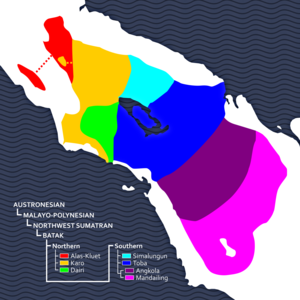Batak Karo language
Karo, referred to in Indonesia as Bahasa Karo (Karo language), is an Austronesian language that is spoken by the Karo people of Indonesia. It is used by around 600,000 people in North Sumatra. It is mainly spoken in Karo Regency, southern parts of Deli Serdang Regency and northern parts of Dairi Regency, North Sumatra, Indonesia. It was historically written using the Batak alphabet which is descended from the Brahmi script of ancient India by way of the Pallava and Old Kawi scripts, but nowadays only a tiny number of Karo can write or understand the script, and instead the Latin script is used.
| Karo | |
|---|---|
| Cakap Karo | |
| Native to | Indonesia |
| Region | Karo Regency, North Sumatra |
Native speakers | (600,000 cited 1991)[1] |
| Batak, Latin | |
| Language codes | |
| ISO 639-3 | btx |
| Glottolog | bata1293 |
 The distribution of Batak languages in northern Sumatra. Karo is represented by the yellow shade. | |
Classification
Karo is a Northern Batak language, and is closely related to Pakpak and Alas.[2] It is mutually unintelligible from the Southern Batak languages, such as Toba, Angkola and Mandailing.[2]
Dialects
There are several dialects within Karo. A major dialect boundary exists between the dialects spoken in the east and the dialects spoken in the west.[2] These are largely distinguished according to phonological and lexical differences. Vowels in the eastern dialect are lowered and fronted in the western dialect. Similarly, diphthongs in the eastern dialect are realised as monophthongs in the western dialect.[2]
| Eastern dialect | Western dialect | |
|---|---|---|
| /waluh/ | /waloh/ | eight |
| /sitik/ | /sitek/ | a little |
| /məlɯhe/ | /məlihe/ | hungry |
| /dʒauŋ/ | /dʒoŋ/ | corn |
Phonology
Karo has 17 consonant phonemes and 10 vowel phonemes.[2]
Consonants
| Labial | Alveo-dental | Palatal | Velar | Glottal | |
|---|---|---|---|---|---|
| Stops | p, b | t, d | c, ɟ | k, ɡ | |
| Nasals | m | n | ŋ | ||
| Fricatives | s | h | |||
| Lateral | l | ||||
| Vibrant | r | ||||
| Semi-vowel | j | w |
Sample
Karo
Ope denga ijadiken Dibata doni enda Kata e enggo lit. Kata e ras Dibata, janah Kata e me Dibata
English Translation
In the beginning was the Word, and the Word was with God, and the Word was God.
References
- Karo at Ethnologue (18th ed., 2015)
- Woollams 2005
Bibliography
- Norwood, Clodagh (1996). "Karo Batak: passive, ergative or neither?" (PDF). La Trobe Working Papers in Linguistics. 9 (6): 101–120. Archived from the original (PDF) on 2008-08-21.CS1 maint: ref=harv (link)
- Norwood, Clodagh (2001). "Actor voice in Karo Batak". La Trobe Working Papers in Linguistics. 11 (7): 161–188.CS1 maint: ref=harv (link)
- Woollams, Geoff (1996). A Grammar of Karo Batak, Sumatra (PDF). Pacific Linguistics Series C - No. 130. Canberra: Pacific Linguistics. doi:10.15144/pl-c130. hdl:1885/145878. ISBN 0-85883-432-4.CS1 maint: ref=harv (link)
- Woollams, Geoff (2005). "Karo Batak". In Alexander Adelaar; Nikolaus P. Himmelmann (eds.). The Austronesian Languages of Asia and Madagascar. London: Routledge. pp. 534–561.CS1 maint: ref=harv (link)
External links
| Batak Karo language test of Wikipedia at Wikimedia Incubator |